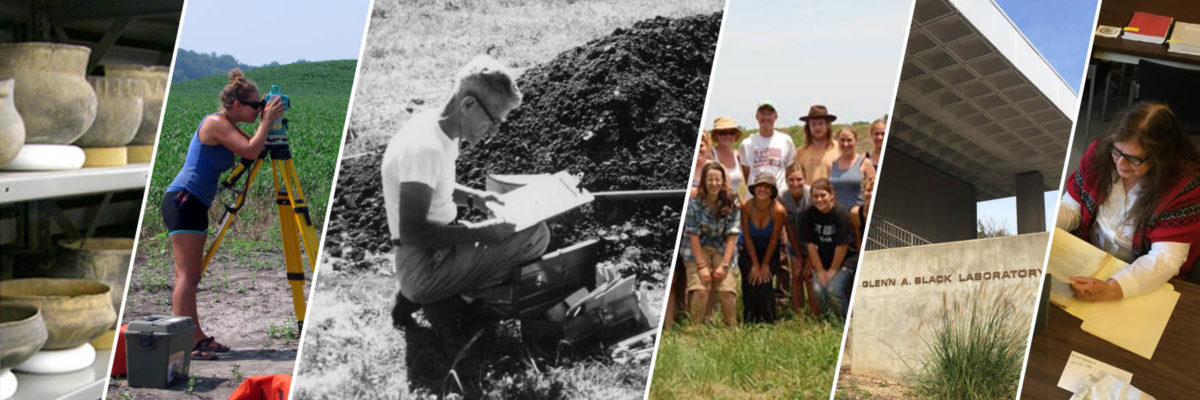by Bailey Foust
I began at the GBL as a work-study student starting my senior year at IU, in fall of 2015. I worked with Alex Elliott on the Type Collection Drawers for my first few weeks before moving onto the Historic Image Collection. At the time my only knowledge of Angel Mounds was that it was near Evansville and that my paternal grandparents took my brother on a trip there without me. Now the majority of what I know comes from working with images of the site. Before I began working with the Historic Image Collection, the media room had the aroma of an open jar of pickles, called vinegar syndrome, it was an evident clue that the lab’s film was deteriorating.

September 2015 to August 2016
I started with the slide collection, which was housed between two slide cabinets, one equipped with a light box. Currently there are 7,117 slides in the inventory. I would remove slides by row, record their information, and assign a catalog number. I then digitized the slides, (the scanner model I used was Epson Perfection v700 photo). Eventually the slides were removed from their hangers and placed in archival boxes (there are 35 in total). The slide collection as a whole contains a fair amount of duplication of negatives and Polaroids; it also contains more candid images from digs than the negative collection, which often focus on documenting excavation features.

Bailey Foust removing slides from the cabinet and placing them in archival boxes. Photo by Jennifer St Germain. 
Bailey Foust in the process of digitizing slides. Photo by Jennifer St Germain.
August 2016 – February 2018
I moved on to the 7,200 negatives; they were originally housed in two filing cabinets with old envelopes. Opening these drawers would release a powerful odor of vinegar syndrome.
The negative inventory was started by Colin Gliniecki, while I worked on the slides, but was completed by me as Colin moved onto other projects. I started the negative digitization by scanning the 4” x 5” negatives that are in good condition, this is a total of 2,977 negatives. I rehoused the negatives to new envelopes as I scanned them, rewriting the caption as best I could. Since scanning has downtime, I continued writing captions for new envelopes. Eventually I started placing the rehoused negatives in archival boxes. As more negatives went in archival boxes, they were removed from the filing cabinet and placed on shelving in the closet. The vinegar syndrome smell lessened once the negatives had new envelopes and were in archival boxes.
After scanning the 4” x 5”s, Jennifer St. Germain purchased an anti-newton ring glass dry mounting so the approximately 4,500 negatives of other sizes could be scanned. To uses this I had to tape the corners of each negative to the glass. This was more time consuming, as I couldn’t prep the next negative until scanning was complete.
A note on condition: Many of the GBL’s negatives are in fine condition but others have experienced deterioration called channeling.

It starts as warping and bubbles in the negative but eventually leads to the emulsion and plastic support separating.
Image Collections Online
Once a sizable number of images had been digitized, Jen worked with IU Digital Libraries to create the GBL’s Image Collections Online Site (ICO). ICO is photo cataloging application that allows us to store and share the GBL’s images.
Directory
One of my roadblocks was that I didn’t have an overall sense of people’s names. They often appear as shorthand, a nickname, or just the surname; so it wasn’t always apparent to me that a name was a name. For example “F.M.S.” is Frank Meryl Setzler and “West” is La Mont West. In order to have accurate and consistent information, I started a list of people’s names. This led me to create a directory of persons for Angel Mounds Field Schools 1945-1962. The directory puts together some basic information, a portrait, full name, institution and class during attendance. To help with this task, I looked though the Angel Mounds Associated documents and field school applications.
Prints

The original print drawers in the GBL media room, 2016. Photo by Bailey Foust. 
The archival boxes containing the print collection. 
Negative boxes in closet ready for the freezer.
I suspect that the core print collection was started by Glenn Black, as some of the captions are followed by his initials. The prints are mounted on cards typed with captions, unfortunately the cards are warped. These prints started out in wooden drawers, but were moved to archival boxes. These boxes have been organized by unit (in the case of Angel Mounds), county (if from Indiana), and state. The number on the card, should in theory, accurately link to the negative (which is now, hopefully, digitized).
With summer ending and the humidity lowering, it was finally time to package the slide and negative boxes for the freezer. In total I packaged 112 boxes. After creating and applying labels to the boxes, they were wrapped in vapor proof barrier.
Tape was applied over all the seams, and an additional label was placed on the barrier exterior. It then went into a bag with a humidity indicator that was sealed and taped up. The difference between packaging slides and negatives, is slides were bagged in groups of 4 and negatives as singles.
Once the freezer was full, Jen and I plugged it in and turned on, it made a happy beeping- I thought it sounded celebratory.
Here are a few of my favorite images:




















